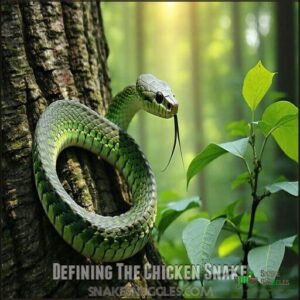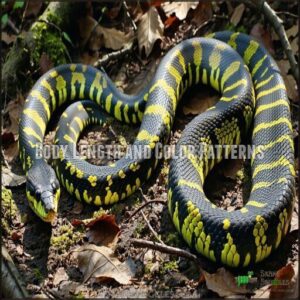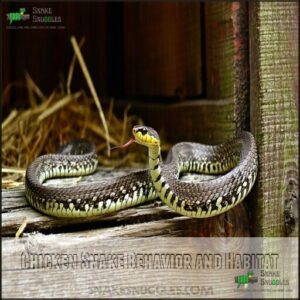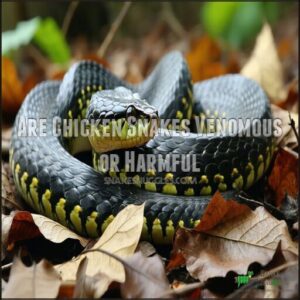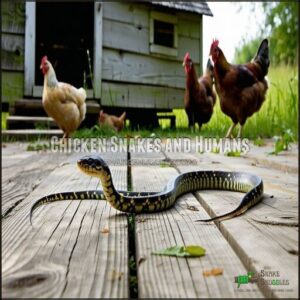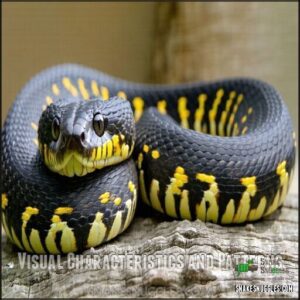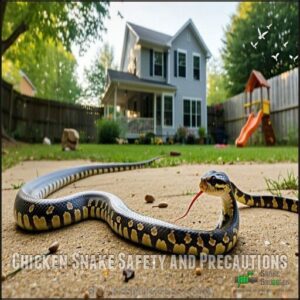This site is supported by our readers. We may earn a commission, at no cost to you, if you purchase through links.
 A chicken snake isn’t a specific snake species—it’s a casual name people use for several nonvenomous snakes, like rat snakes.
A chicken snake isn’t a specific snake species—it’s a casual name people use for several nonvenomous snakes, like rat snakes.
The “chicken” part comes from their tendency to sneak into coops to snack on eggs, but don’t worry, they’re more interested in rodents than poultry.
These snakes are long, slender, and come in different colors, often with blotches or stripes. You’ll find them in forests, fields, and yes, sometimes near farms.
They’re great climbers and play an important role in controlling rodent populations.
So, while they might spook you, chicken snakes are harmless neighbors with a knack for pest control.
Table Of Contents
- Key Takeaways
- Defining The Chicken Snake
- What is a Chicken Snake
- Chicken Snake Diet and Hunting
- Physical Characteristics of Chicken Snakes
- Chicken Snake Behavior and Habitat
- Are Chicken Snakes Venomous or Harmful
- Chicken Snakes and Humans
- Identifying Chicken Snakes
- Chicken Snake Safety and Precautions
- Debunking Chicken Snake Myths
- Frequently Asked Questions (FAQs)
- Are chicken snakes venomous?
- How do chicken snakes hunt?
- Are chicken snakes aggressive?
- Where do chicken snakes live?
- What do chicken snakes eat?
- How do you identify a chicken snake?
- What does a chicken snake look like?
- Where do you find chicken snakes?
- Are chicken snakes good pets?
- What is the meaning of chicken snake?
- Conclusion
Key Takeaways
- You’ll find chicken snakes, also called rat snakes, sneaking into coops for eggs, but they mostly eat rodents and help control pests.
- They’re harmless and nonvenomous, using constriction to hunt prey like birds, lizards, and mice.
- Their smooth, shiny scales and bold color patterns, like gray, brown, or black, make them easy to identify.
- These snakes are great climbers and thrive in forests, barns, and even suburban areas near water.
Defining The Chicken Snake
You’ve probably heard of chicken snakes, but they’re not what you think they are. They’re nonvenomous, agile climbers with sleek bodies, often mistaken for something more dangerous.
Nonvenomous and misunderstood, chicken snakes are nature’s stealthy climbers—harmless helpers often mistaken for something far more fearsome.
Scientific Name and Meaning
The chicken snake’s scientific name, Pantherophis guttatus, might sound fancy, but it has humble roots tied to its "egg thief" reputation.
Known for sneaking into henhouses, this snake isn’t after chickens—it’s raiding nests for eggs!
Its taxonomic significance places it in the Colubridae family, the largest snake family.
Here’s what makes it interesting:
- Etymology origins trace the name back to Greek and Latin roots.
- Its evolution reflects the mistaken belief it hunted chickens.
- Common names like "rat snake" highlight its role as a rodent hunter.
Despite its quirks, the chicken snake is harmless, venom-free, and an excellent pest controller.
Physical Characteristics and Appearance
When you spot one, their snake appearance is hard to miss. These snakes boast impressive size variations, often stretching up to 6 feet, and their slender body shape adds to their elegance.
Their body coloration ranges from brown, gray, or tan with eye-catching designs.
Look closer, and you’ll notice these highlights:
- Smooth scale patterns cover their shiny skin, like nature’s polish.
- Head markings include dark bands near the eyes, adding character.
- Small teeth perfect for eating—not biting—make them harmless.
- Unique markings distinguish each one by region.
- Sleek and fearless climbers, they’re nature’s stealth acrobats.
Different Species and Types
There’s an interesting variety of chicken snakes—each with distinct traits.
Here’s a quick rundown of five types of chicken snakes.
Species Color Native Range
These non-venomous snakes thrive in forests, barns, and backyards!
What is a Chicken Snake
You might know chicken snakes by their other name, rat snakes, but don’t let the nickname fool you—they’re more than just rodent catchers.
These nonvenomous snakes are expert climbers and thrive in forests, barns, and even suburban areas.
Habitat and Geographic Distribution
Did you know these snakes are nature’s climbers and homebodies?
They thrive in forest habitats, rural landscapes, and suburban habitats, adapting to almost any environment.
You’ll find them across impressive geographic ranges, from southern Mexico to South America.
Their urban adaptation even puts them near homes or chicken coops!
Rattlesnakes, however, have a different geographic range.
Here’s where they hang out:
- Forest ecosystems with cozy trees and water nearby.
- Rooftops and barns in rural areas, controlling pests.
- Suburban spots, sneaking into backyards.
With their climbing behavior, they’re always up for an adventure!
Diet and Hunting Techniques
When it’s time to eat, these rat snakes are all about skill and patience. Their snake hunting tactics can get pretty wild:
- Prey constriction: They coil tightly around their victims, using constriction methods to subdue rodents, birds, or even lizards.
- Hunting strategies: Opportunists at heart, they’ll go for anything edible—like rodents, eggs, or birds.
- Scavenging habits: If it’s already dead, it’s still dinner.
- Egg consumption: Golf balls? Sometimes mistaken for eggs!
These adaptable creatures play a key role in rodent control through their efficient snake diet.
Behavior and Lifestyle
Chicken snakes are masters of stealth, thriving with their laid-back, solitary nature—except during mating season.
These nocturnal snakes spend nights hunting using sharp senses and ambush strategies.
Their climbing skills let them explore trees, barns, and rooftops with ease.
Come winter, their hibernation patterns kick in as they settle into burrows or cozy hideouts.
| Behavior | Details |
|---|---|
| Socialization | Mostly solitary, mates briefly |
| Activity Pattern | Nocturnal, hunts quietly |
| Habitat Choice | Trees, old barns, burrows |
It’s like watching nature’s sneakiest ninja at work!
Chicken Snake Diet and Hunting
Regarding food, chicken snakes are expert hunters with a taste for rodents, birds, and eggs.
They rely on stealth and powerful constriction to catch and subdue their prey, playing a key role in balancing local ecosystems.
Prey and Predation Techniques
Regarding hunting, these snakes are nature’s stealth artists, blending into their surroundings like camouflage experts.
They excel in snake ambush techniques, lying motionless in vegetation or tree branches until prey wanders too close. With a sharp sense of smell and taste, they detect rodents, birds, and even eggs.
Once they spot a target, their hunting strategies switch to action. Striking quickly, they use constriction methods to overpower their prey, coiling tightly until it can’t escape. It’s all about efficiency in the food chain!
- Wait patiently, fully concealed within their habitat.
- Select prey carefully, aiming for manageable prey like mice or birds.
- Constrict skillfully, ensuring a swift and secure capture.
Food Sources and Consumption
Their meals aren’t picky—they eat whatever fits their jaws! Rodents, birds, eggs, and lizards are their top choices, often snagged using constriction. Unlike some snake prey hunters, they don’t shy from convenience.
- Fun fact: They sometimes eat chicken eggs (or even golf balls by mistake!).
This opportunistic feeding and rodent control make them surprise heroes in nature’s pest management!
Impact on Local Ecosystems
Chicken snakes are natural pest controllers, balancing ecosystems by reducing rodents, managing bird populations, and even targeting eggs.
They keep the food chain in check but can disrupt habitats if populations grow unchecked.
Want to keep things in harmony?
- Support rodent control by respecting their role.
- Monitor bird dynamics wisely.
- Preserve forest ecosystems thoughtfully.
- Encourage natural habitat balance whenever possible.
Physical Characteristics of Chicken Snakes
You’ll recognize chicken snakes by their long, slender bodies and striking patterns that vary from gray and brown to even orange.
Their shiny scales and unique markings make them stand out, but don’t worry—they’re all style and no venom.
Body Length and Color Patterns
Snake size and color variation can leave you amazed!
These snakes measure between 2 and 6 feet long, with some reaching a whopping 8 feet.
Their body shape is long and slender, with rich color morphs like brown, gray, or even yellow with black bands.
Juvenile markings often differ from adults, adding to their charm.
Here’s a snapshot:
| Feature | Details | Fun Fact |
|---|---|---|
| Length Range | 2–6 feet | Some hit 8 feet! |
| Max Length | 8 feet | Oklahoma sightings stand out. |
| Colors | Brown, gray | Blends perfectly in nature. |
| Patterns | Yellow, black bands | Unique regional differences. |
| Head Markings | Distinct shapes | Useful for identification. |
Distinctive Features and Markings
You can easily recognize chicken snakes by their slender body shape, shiny scales, and bold color variations.
Look for their signature yellow and black crossbands or dark head markings near the eyes.
Their tails often showcase unique scale patterns, either solid or striped.
These markings serve a purpose, blending them into their surroundings or mimicking more dangerous snakes. Distinct band patterns offer insights into snake biology.
- Bold yellow and black bands that catch your eye
- Smooth scales gleaming under sunlight
- Earthy browns and grays with dramatic contrasts
- Striking eye lines for easy recognition
- Patterns differing across subspecies
Variations in Appearance
Chicken snakes show off quite the variety when it comes to appearances!
Their color variations range from black to gray, yellow, brown, or even orange.
You’ll notice scale patterns like stripes, checkers, or blotches—they’re like nature’s fashionistas.
Regional variations play a role, too, with the Eastern Rat Snake sporting dramatic designs, while the Gray Rat Snake might lean toward subtle tones.
Don’t forget juvenile coloration, as young snakes often have brighter, more striking patterns.
By their body shape, scale texture, and unique markings, identifying these snakes gets much easier!
Chicken Snake Behavior and Habitat
You’ll often find chicken snakes exploring forests, barns, or even rooftops, as they’re skilled climbers and love to hide in high places.
These solitary snakes are mostly active at night and use their stealthy moves to hunt or avoid danger.
Social Structure and Nocturnal Behavior
Chicken snakes are the introverts of the reptile world.
They embrace a solitary nature, with little interest in mingling unless it’s mating season.
Their nocturnal patterns shine when hunting rodents or birds under the moonlight. While skilled hunters, they rarely socialize, preferring stealth.
If threatened, they might show a bit of bravado with body inflation or tail vibrations, mimicking scarier snakes. They may also use tail movements as warning signals.
Preferred Environments and Habitats
Chicken snakes are incredibly adaptable regarding their living spaces.
You’ll often find them in forest habitats, rural landscapes, or even making themselves at home in suburban areas.
They’re a natural fit for wetland habitats and spots near water, taking advantage of their surroundings. Barns? Perfect for pest control.
Their knack for blending into various snake habitats, from cozy burrows to high grass, is uncanny.
Across the Southeast U.S., regional variations add to their charm—these sly climbers thrive wherever they can find nocturnal shelters.
Climbing Abilities and Tree-dwelling
Imagine a gymnast in the wild—that’s a chicken snake in action.
With their arboreal adaptations, they master treeclimbing like pros, excelling at trunk scaling and precise branch navigation.
These snakes explore elevated areas with ease, hunting in the forest canopy and thriving in vertical habitats.
Their agility aids predation avoidance while raiding nests, making them impressive athletes perfectly suited to life among the trees.
Are Chicken Snakes Venomous or Harmful
Chicken snakes aren’t venomous, so you don’t have to worry about deadly bites.
No venom here—just a sleek, harmless predator keeping rodents and pests in check naturally.
However, they can still give a pretty painful nip and might constrict smaller animals if threatened.
Nonvenomous Nature but Potential Risks
Regarding chicken snakes, "nonvenomous" doesn’t mean harmless.
These agile climbers might bite if they feel trapped, though their bites aren’t toxic. Still, it’s not fun and might startle you!
Pet safety is another thing to watch for—smaller animals, like hamsters or chicks, could be at risk around these sneaky hunters.
To keep things safe:
- **Install snake-proof barriers around coops and homes.
Effective protection includes installing reliable exclusion methods. Don’t forget to seal gaps in walls, trim back plants, and make certain food waste doesn’t attract rodents (a chicken snake’s favorite snack).
Prevention keeps you and your pets safe!
Constricting Behavior and Threats to Humans
Think a snake without venom is harmless?
Not so fast—these constrictors have a strong constricting ability, wrapping tightly around prey and suffocating it. Their constriction strength is impressive, but for humans, there’s little to worry about.
Chicken snakes rarely bite unless they feel threatened, and even then, Bite Risk is quite low. While their Venomous Mimicry (like vibrating their tails) may startle you, they pose no actual venom danger.
Your pets and small children are more vulnerable. Pet Safety is key—keep small animals away if one’s nearby.
Their constricting strength, while designed for rodents or birds, could harm tiny pets.
Consider using specialized protective gear when dealing with snakes.
Child Safety tips include teaching kids not to handle wild snakes—it’s their space, not ours.
Prevention and Protection Measures
If a chicken snake’s been snooping around, no need to panic—simple steps can keep them out.
Start by strengthening barriers with snakeproof fencing for first-rate snake control.
Pets? Train them to steer clear of snakes for better pet safety.
Clear out hiding spots—debris piles, tall grass, or overgrown bushes.
Need extra snake protection? Apply diatomaceous earth or snake repelling pellets.
For effective protection, consider installing exclusionary garden barriers.
If one sneaks in, call a professional for snake removal.
Prevent, exclude, and embrace coexistence education!
Chicken Snakes and Humans
You’ll often find chicken snakes near human homes, especially in barns or chicken coops, thanks to their love for rodents and eggs.
While they’re harmless to people, their curious nature can sometimes cause a scare.
Cultural Significance and Folklore
Folklore origins have painted chicken snakes as powerful figures across cultures.
In North America, they’re seen as household guardians, bringing good luck, while Indigenous legends tie them to creation myths and Earth’s balance.
Rural tales claim these snakes keep pests in check, earning their spot as nature’s sly caretakers.
Snake symbolism varies—some see mythical powers, others fear them unjustly.
These wildlife legends show how humans interpret chicken snakes, blending fact with snake myths that spark curiosity and wonder.
Human Impact on Chicken Snake Population
People often misunderstand chicken snakes, but human actions play a big role in their struggles.
Habitat loss pushes them out of forests and into risky human dwellings, where pesticide use and road mortality are everyday threats. The pet trade also impacts snake conservation by removing them from their natural snake habitat.
Opportunistic feeders, they’re drawn to chicken coops, sparking fear and unnecessary snake removal.
Climate change adds another layer, shifting environments and disrupting prey availability.
These nonvenomous snakes face plenty of challenges, and it’s up to us to reduce harm and coexist peacefully with these helpful predators.
Conservation Efforts and Future Prospects
Protecting chicken snakes means preserving their habitats and balancing the ecosystem. Conservation efforts focus on habitat preservation, public education, and understanding species preservation.
Here’s how you can help:
- Support wildlife groups promoting snake conservation and habitats.
- Reduce population threats by encouraging biodiversity restoration.
- Use snake-proof fencing near homes to coexist peacefully.
- Back snake research for better ecological understanding.
- Share facts to combat myths and boost species appreciation.
Small actions today shape the future outlook. Let’s give these nonvenomous helpers the respect they deserve!
Identifying Chicken Snakes
You can spot a chicken snake by its long, slender body, shiny scales, and striking color patterns like black, gray, or tan.
Look for their smooth texture and distinct markings to tell them apart from other snakes.
Visual Characteristics and Patterns
You’ll spot a chicken snake by its unique scale patterns and color variations.
These snakes flaunt black and yellow bands, rich browns, or blotchy creams.
Their slender body shape, smooth scales, and distinctive dark markings make them stand out.
Whether perched in a tree or slinking through grass, their striking appearance truly highlights their subspecies differences.
Distinguishing From Other Snake Species
How can you tell if the snake you’re looking at is a chicken snake? It’s not as hard as it sounds.
- Body and Head Shape: Chicken snakes have slender bodies that lead into a rounded head, unlike venomous snakes with their broad, triangular heads.
- Scale Patterns: Look for smooth, shiny scales with black-and-yellow bands, blotches, or other distinct patterns. They lack rough textures, setting them apart from other species.
Here’s a fun twist: they mimic rattlesnakes by rattling their tails, but there’s no rattle involved!
When figuring out snake identification, Habitat Overlap and Behavior Differences are useful clues to pinpoint which non venomous snake you’re observing.
Importance of Accurate Identification
Accurate snake identification saves lives—yours and the snake’s!
Many confuse a harmless chicken snake with venomous look-alikes, leading to harm or panic.
Chicken snakes, like rat snakes or corn snakes, have smooth scales and round pupils. Their harmless misidentification impacts conservation and public safety.
Learn these simple traits to avoid species confusion:
| Feature | Chicken Snake | Venomous Look-alike |
|---|---|---|
| Scales | Smooth | Rough or keeled |
| Pupils | Round | Slit-like |
| Behavior When Threatened | Non-aggressive | Defensive/aggressive |
Understanding these differences makes safer interactions and aids conservation efforts.
Chicken Snake Safety and Precautions
If you spot a chicken snake near your home, it’s important to stay calm and give it space.
Taking simple precautions, like sealing gaps and using natural deterrents, can help keep both you and the snake safe.
Handling With Caution and Respect
Handling a chicken snake isn’t risky if you play it smart and show respect.
While they’re nonvenomous, bites can still happen if they feel cornered.
Here’s a quick guide for safe handling:
- Maintain a respectful distance—observation beats confrontation.
- Use safety gear, like sturdy gloves, to protect your hands.
- Move slowly and calmly—sudden actions trigger defense modes.
- Try relocation methods, such as a snake hook for gentle removal.
- Coexist peacefully—when in doubt, call an expert for snake removal.
Stay safe while respecting wildlife!
Snake-repelling Smells and Deterrents
Keeping chicken snakes away can be as simple as using scent-based repellents.
Natural deterrents like garlic or citronella oil work wonders—garlic’s strong odor sends snakes packing, while citronella smells great to humans but not to these slithery visitors.
Prefer chemicals? Ammonia packs a punch but has a harsh smell.
Need convenience? Commercial repellents offer versatility but can get pricey.
Whatever you use, remember that repellent effectiveness improves with strategic application methods.
Pair odor deterrents with barriers like snake-proof fencing for foolproof snake management.
Snake avoidance and removal don’t have to feel impossible!
Professional Assistance for Snake Management
Discovering a snake in your home can be a nerve-wracking surprise, but calling a professional is your safest bet.
Snake removal experts provide emergency snake capture, identify snake species accurately, and guarantee safe relocation with professional relocation services.
Why DIY when expert consultation guarantees effective results without risking bites or damage?
Snake removal costs are worth the peace of mind, as these pros use specialized tools and preventative property measures to keep your space snake-free.
Let the professionals handle snake management—whether it’s catching a chicken snake or securing your property, they’ve got the know-how to solve the problem efficiently.
Debunking Chicken Snake Myths
You’ve probably heard some wild stories about chicken snakes, but not everything you’ve been told is true.
Let’s separate fact from fiction and uncover the real science behind these misunderstood reptiles.
Misconceptions and Misinformation
Let’s tackle some snake myths and set the record straight with a bit of snake myth busting:
- They’re not slimy—chicken snakes feel sleek, almost like smooth leather, not wet or gooey.
- "Dislocating jaws" is false—their mouths simply stretch wide to handle prey.
- "Venomous look-alikes" worries? Don’t panic—they’re harmless constrictors, though an occasional bite could sting.
Another surprising chicken snake fact? They shed their skin not just for growth but to ditch pesky parasites.
Like other snakes, they also lack external ear openings.
Snake facts like these can reshape wildlife legends!
Separating Fact From Fiction
Chicken snake rumors are as wild as their patterns.
Common misconceptions link these harmless snakes to venomous vipers, but that’s just folklore origins talking.
Identifying myths starts with snake identification: no triangular heads, slit pupils, or venom here!
Exaggerated dangers often stem from their bold colors, but chicken snakes, a nonvenomous type of rat snake, pose no real threat.
Their role in ecosystems outweighs the fear factor—leave the tall tales behind where they belong, focusing on the nonvenomous nature of these snakes.
Promoting Accurate Understanding and Appreciation
Understanding chicken snakes, or rat snakes, reduces fear and promotes coexistence with these nonvenomous creatures.
Appreciating their ecological importance starts with busting snake myths and learning about their harmless nature.
They’re pest controllers, not villains!
Here are five tips to grow your knowledge:
- Learn basic snake identification to separate fact from fiction.
- Respect wildlife by giving them space rather than reacting impulsively.
- Research their ecological importance in controlling pests like rodents.
- Understand their role as nonvenomous contributors to nature’s balance.
- Share facts to replace fear with curiosity in your community.
Frequently Asked Questions (FAQs)
Are chicken snakes venomous?
Nope, chicken snakes aren’t venomous.
They may look intimidating with their size and patterns, but they’re harmless to humans.
Instead, they rely on constriction to hunt prey like rodents, birds, and eggs.
How do chicken snakes hunt?
They’re like stealthy ninjas.
Chicken snakes hunt by ambushing their prey, grabbing it, and using their muscles to squeeze tightly.
After that, they swallow it whole. It’s efficient, though not exactly the dinner party approach.
Are chicken snakes aggressive?
It’s funny how such a long snake can seem intimidating, but they’re not aggressive.
Chicken snakes prefer to flee when spotted.
If cornered, they might hiss or vibrate their tails, but it’s all bluff.
Where do chicken snakes live?
Chicken snakes live in forests, grasslands, barns, and urban areas across North and Central America.
You’ll often find them climbing trees, hiding in rooftops, or near water.
They even hang around chicken coops—hence the name!
What do chicken snakes eat?
Imagine finding one slithering near a chicken coop—it’s probably hunting rodents, birds, or eggs.
Chicken snakes love controlling pests like mice but will also snack on lizards, frogs, or even an occasional bird’s egg.
How do you identify a chicken snake?
You can spot a chicken snake by its long, slender body (up to 6 feet), shiny scales, and patterns in black, gray, or brown.
Big round eyes and smooth scales complete their distinct look.
What does a chicken snake look like?
You’d notice its sleek body, shiny scales, and bold patterns.
Colors range from gray or brown to vibrant orange, often with dark stripes.
These long, slender snakes are experts at climbing trees and rooftops.
Where do you find chicken snakes?
You’ll find chicken snakes in forests, grasslands, barns, and even your attic.
They’re great climbers, sneaking into trees or rooftops.
They prefer warm spots and are common near water, often hunting rodents or bird eggs.
Are chicken snakes good pets?
Keeping a chicken snake as a pet can be tricky.
They’re nonvenomous, great at pest control, but need spacious habitats.
They’re not cuddly and might escape, so be prepared for their Houdini-like climbing skills!
What is the meaning of chicken snake?
A chicken snake, also known as a rat snake, is a harmless, nonvenomous snake often found near chicken coops.
Eating rodents, birds, and eggs, they keep pests in check and rarely bother humans. Eating rodents, birds, and eggs, they keep pests in check and rarely bother humans.
Conclusion
Picture a sleek, blotchy snake gliding through trees or coiled near a barn, hunting mice and controlling pests.
That’s the surprising answer to “what is a chicken snake”—a nature-made exterminator, not a threat.
These nonvenomous climbers may sneak eggs but mostly prefer rodents, helping balance ecosystems.
Spot one? Don’t panic. Instead, appreciate their pest control skills and leave them be.
After all, they’re harmless neighbors doing their part in nature’s big picture.

